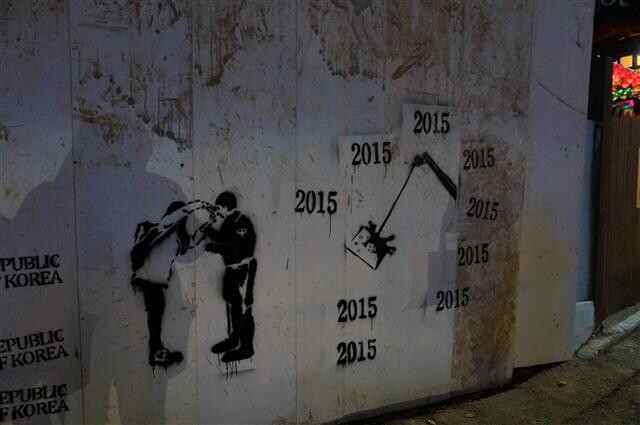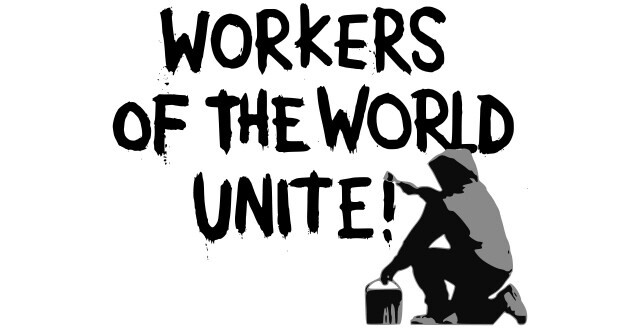hankyoreh
Links to other country sites 다른 나라 사이트 링크
Graffiti artists paint Seoul with subversion in the darkness of night

On Nov. 21, Kim was back on the street leaving another image on the urban canvas.
A and his colleague B were at the mostly deserted Exit 5 of the Hongik University subway station at 11:30 that night, wearing masks and black hoodies to cover their heads. Their form of art, which uses graffiti to voice socially critical messages, is not welcomed, and Kim and Lee had to work in secrecy to avoid being caught by police. (Kim and Lee are pseudonyms used to protect the interviewees’ identities.)
“I saw a temporary construction site fence that already had a bit of graffiti on it. I thought it would be safe, since it’s going to come down anyone, but the security was really tight,” Kim sighed.
Kim described an exchange between a police officer and French graffiti artist Space Invader in “Exit Through the Gift Shop,” a documentary by the British street artist Banksy. The police officer says, “You’re putting up graffiti. Get out of here.” Space Invader responds, “This isn’t graffiti. It’s art.”
It was through watching these moments that Kim became fascinated with graffiti as a way of upending custom and criticizing society.
In June, the National Police Agency declared graffiti a crime and announced plans for a severe crackdown. Artists who are caught making it are typically charged with breaking and entering or damaging public poverty.
Kim began to work quickly while Lee stood guard. In graffiti, speed is key. This is why Kim usually works in stencil, cutting out pre-made patterns on a sheet to spray-paint through. The image is left behind when the sheet is taken away. Kim single image typically takes no more than ten minutes to make.
Tonight’s image showed a demonstration participant tending to a police officer in agony from capsaicin exposure. It was adapted from a photo that drew major social media attention in the wake of a massive rally in central Seoul on Nov. 14.
“I wanted to show that we don’t need to do this to each other, that police officers and ordinary people are both citizens of this country,” Kim explained.
Another image showed a state-issued history textbook at the end of a water cannon jet.
“I can’t comprehend a government that tries to make its own ‘proper version’ of history like it’s firing it from a cannon,” Kim shrugged.
Inscribed around the images are small characters that form the text “2015” and “REPUBLIC OF KOREA.”
“The meaning is that we are living in an out-of-control 2015, and that we need to confront the fact that this country is a democratic republic,” Kim said.
Kim remains cloaked in anonymity, but his paintings are usually reported in the media the next day. The “men in sunglasses” and “5163” figures that appeared all around central Seoul in August were his work, as was the “Rising Sun Flag with a laughing Park Geun-hye” that showed up at Sinchon, Hongik University, and other sites in Seoul not long ago - respective critiques of the National Intelligence Service’s use of hacking programs and a recent South Korea-Japan summit, he explained. Many of the works were erased after press reports.
“They only erased my picture, while leaving behind the curse words and other graffiti around it,” A noted, pointed at a spot where one of his Rising Sun Flag images had been.
“It’s censorship of social art,” he sighed.
After over an hour spent working on two walls, Kim’s hands were blackened with spray paint.
“I have to keep going out and painting in the streets to reveal the absurdity of the world and express the truth,” he said. “I hope someday the images I make will become a rallying cry to bring change.”
Kim and Lee slipped off again into the darkness.

By Bang Jun-ho, staff reporter
[Please direct questions or comments to [english@hani.co.kr]

Editorial・opinion
![[Column] Season 2 of special prosecutor probe may be coming to Korea soon [Column] Season 2 of special prosecutor probe may be coming to Korea soon](https://flexible.img.hani.co.kr/flexible/normal/500/300/imgdb/original/2024/0426/3317141030699447.jpg) [Column] Season 2 of special prosecutor probe may be coming to Korea soon
[Column] Season 2 of special prosecutor probe may be coming to Korea soon![[Column] Park Geun-hye déjà vu in Yoon Suk-yeol [Column] Park Geun-hye déjà vu in Yoon Suk-yeol](https://flexible.img.hani.co.kr/flexible/normal/500/300/imgdb/original/2024/0424/651713945113788.jpg) [Column] Park Geun-hye déjà vu in Yoon Suk-yeol
[Column] Park Geun-hye déjà vu in Yoon Suk-yeol- [Editorial] New weight of N. Korea’s nuclear threats makes dialogue all the more urgent
- [Guest essay] The real reason Korea’s new right wants to dub Rhee a founding father
- [Column] ‘Choson’: Is it time we start referring to N. Korea in its own terms?
- [Editorial] Japan’s rewriting of history with Korea has gone too far
- [Column] The president’s questionable capacity for dialogue
- [Column] Are chaebol firms just pizza pies for families to divvy up as they please?
- [Column] Has Korea, too, crossed the Rubicon on China?
- [Correspondent’s column] In Japan’s alliance with US, echoes of its past alliances with UK
Most viewed articles
- 1‘We must say no’: Seoul defense chief on Korean, USFK involvement in hypothetical Taiwan crisis
- 2Is Japan about to snatch control of Line messenger from Korea’s Naver?
- 3AI is catching up with humans at a ‘shocking’ rate
- 4Korea protests Japanese PM’s offering at war-linked Yasukuni Shrine
- 5[Column] Season 2 of special prosecutor probe may be coming to Korea soon
- 6The dream K-drama boyfriend stealing hearts and screens in Japan
- 7‘Weddingflation’ breaks the bank for Korean couples-to-be
- 8No good, very bad game for Korea puts it out of Olympics for first time since 1988
- 9“Korea is so screwed!”: The statistic making foreign scholars’ heads spin
- 10[Column] The clock is ticking for Korea’s first lady